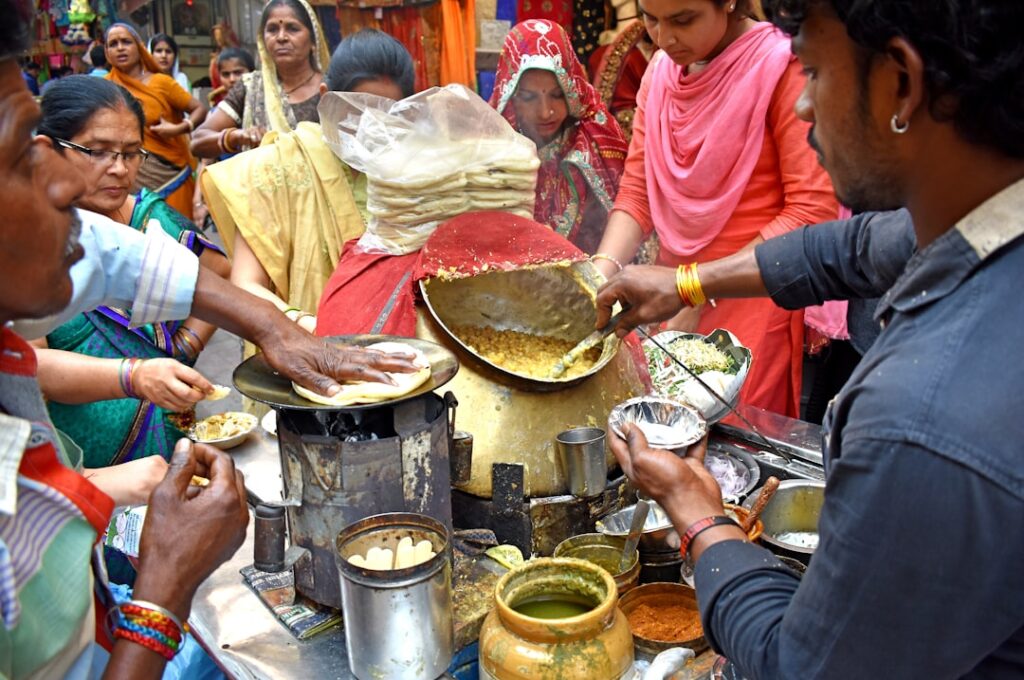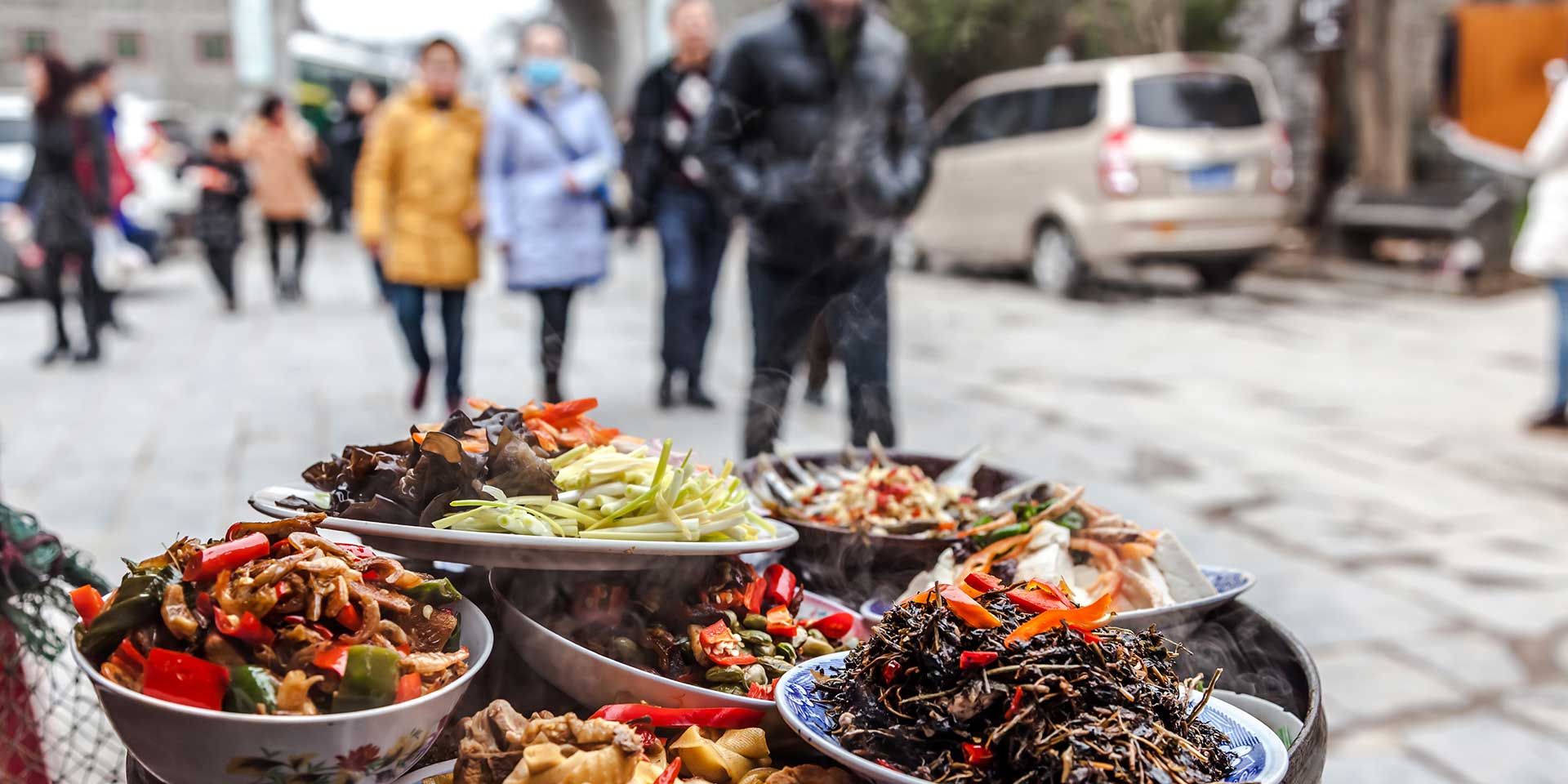Why Food Is the Ultimate Cultural Gateway
Cultural food experiences offer an authentic way to connect with a destination’s heart. The World Food Travel Association defines food tourism as “traveling for a taste of place in order to get a sense of place,” a primary motivation for over half of leisure travelers.
Key Types of Cultural Food Experiences:
- Street food tours and market visits
- Hands-on cooking classes with local chefs
- Traditional dining experiences in heritage settings
- Food festivals and seasonal celebrations
- Farm visits and producer experiences
- Guided neighborhood food walks
As one traveler shared about their revelations: “One of the most exciting parts about traveling is trying new flavors and dishes from around the world.” This sentiment captures why food is such a powerful bridge between cultures.
Food does more than satisfy hunger; it tells stories. A bite of authentic Khao Soi in Chiang Mai or a traditional Māori Hāngī feast is a taste of centuries of tradition, geography, and community values.
The beauty of cultural food experiences is their accessibility. Unlike museums, food culture is everywhere—from busy markets like Montreal’s Jean-Talon to village kitchens. It’s immediate and deeply personal.
Whether it’s comforting poutine in Montreal or edible insects in Mexico City, these experiences can transform how we see the world and ourselves.
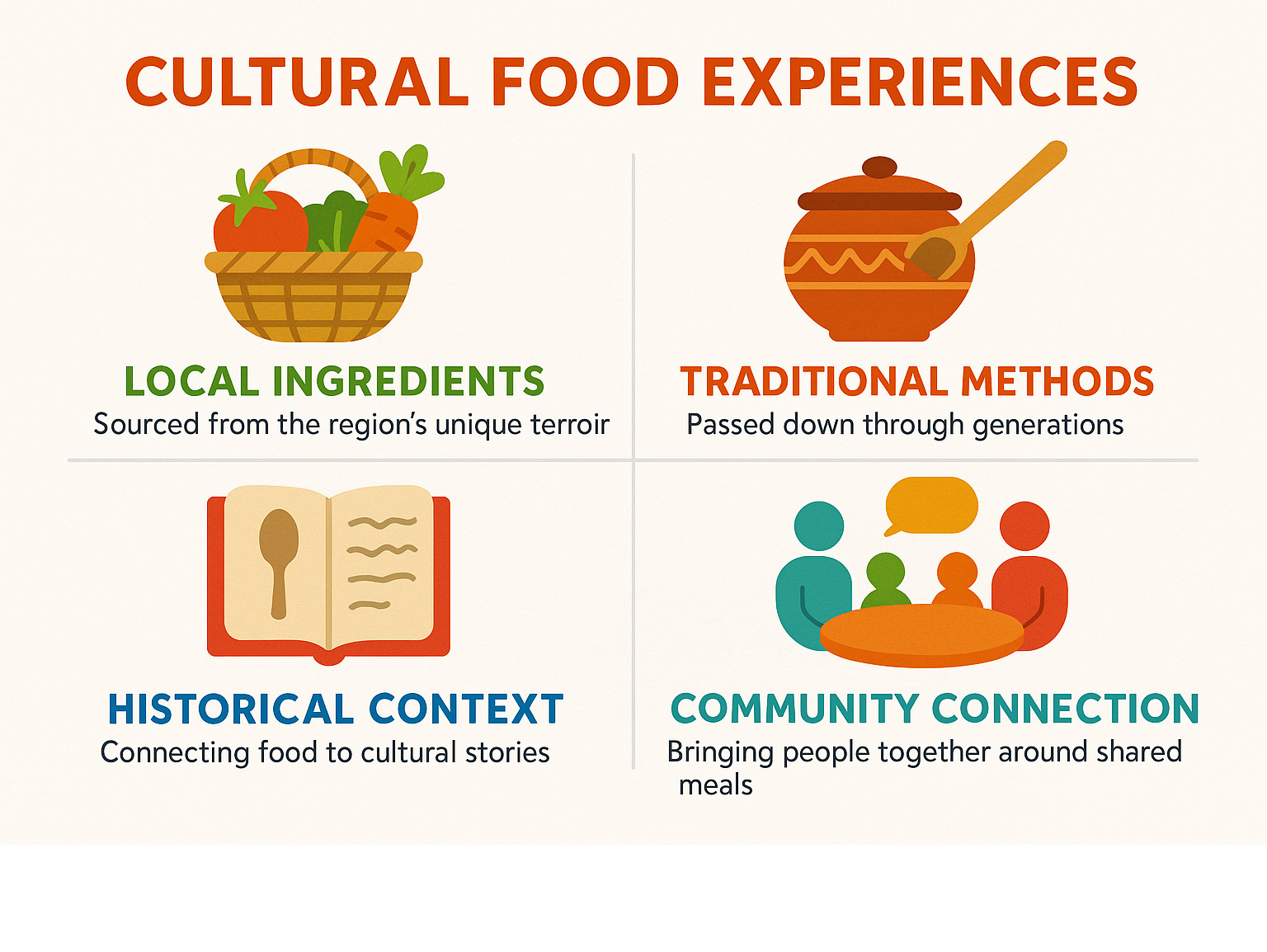
Cultural food experiences vocab to learn:
What Makes a Food Experience Genuinely Cultural?
Imagine slurping noodles at a street stall in Bangkok, a recipe perfected over three generations. The vendor’s smile as you taste her life’s work is what makes a food experience genuinely cultural.
Genuine cultural food experiences are less about fancy restaurants and more about connection—to place, people, and history. Authenticity transforms a meal into a window into another world.
Food is history you can taste. Each bite tells a story of migration and survival. For example, Jollof rice represents cultural pride and identity across West Africa, a symbol of heritage that unites families and nations.
The most genuine experiences are found away from tourist traps, in the neighborhood joints and family kitchens that fuel the hyperlocal food movement.
The Role of Local Ingredients and Terroir
Why does a tomato in Italy taste so different from one at home? That’s terroir—the unique combination of soil, climate, and geography that shapes an ingredient’s flavor.
Prince Edward Island’s mineral-rich soil gives its potatoes a distinctive taste, while Nova Scotia’s Annapolis Valley produces uniquely crisp apples, both perfect examples of terroir. Similarly, Sicilian citrus, kissed by Mediterranean sun, is the backbone of the island’s vibrant cuisine, capturing the essence of the place.
Oysters are another great example; a Malpeque oyster from Prince Edward Island tastes completely different from one from British Columbia, illustrating how geography directly influences our plates.
The farm-to-table movement is less a trend and more a return to tradition. At places like Fox Hill Farm, milk from their own cows becomes gelato and cheese, connecting land to product. This focus on local isn’t just about freshness; it’s about sustainable dining: More Than a Trend that preserves flavor and culture.
How Food Tells a Story of History and Tradition
A smoked meat sandwich from Schwartz’s Deli in Montreal is a taste of the city’s Jewish heritage, made with the same recipe and pride since the 1920s.
In Atlantic Canada, seafood dishes tell the story of Acadian history and immigration. Halifax’s Pier 21 was a melting pot where global flavors blended with local traditions, a process that explains why global flavors are taking over local menus.
Food culture also includes rituals. The Baci ceremony in Laos connects food to spiritual beliefs, while a Māori Hāngī feast in New Zealand is an act of community and celebration that keeps ancient traditions alive.
These meals are acts of cultural preservation, keeping stories alive one bite at a time.
Beyond the Restaurant: Diverse Types of Cultural Food Experiences
The most memorable cultural food experiences often happen outside of formal restaurants. They’re found in busy markets, home kitchens, and at street-side stalls where the best meals are affordable and authentic.
This shift toward more immersive culinary experiences reflects a craving for authentic connection. As detailed in The Rise of Experiential Dining, travelers want to dive into the culinary heartbeat of a destination.
Top 5 Ways to Experience Food Culture:
- Explore Busy Food Markets and Street Food Stalls
- Get Hands-On with Local Cooking Classes
- Join the Celebration at Food Festivals and Local Events
- Participate in Home-Based Dining Experiences
- Take a Guided Culinary Walking Tour
These experiences are a backstage pass to a city’s authentic flavors, revealing the stories, techniques, and community connections behind the food.
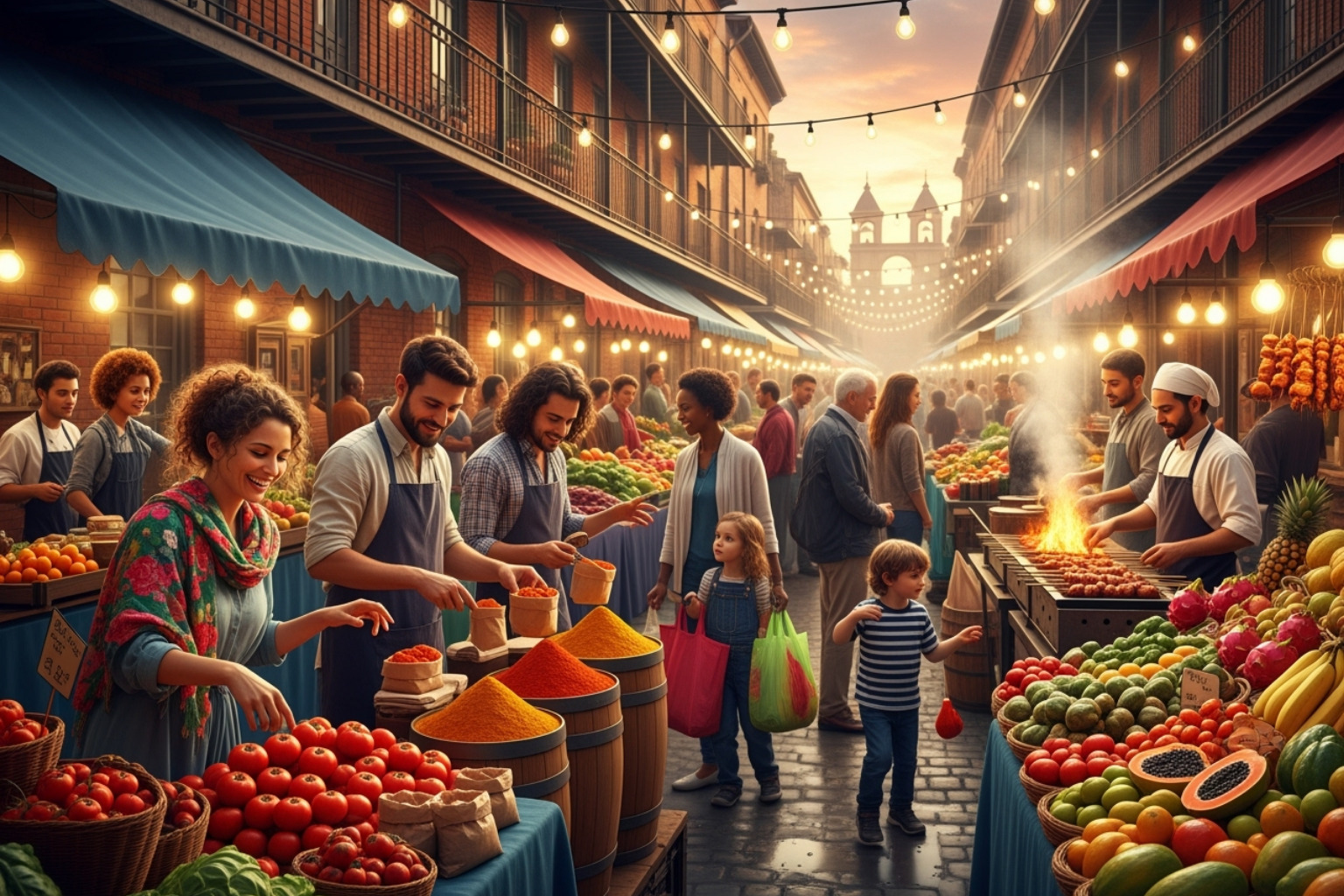
Explore Busy Food Markets and Street Food Stalls
Markets are the culinary soul of a city, community hubs where the rhythm of daily life unfolds. Historic markets like the Halifax Seaport Farmers Market (since 1750), Ottawa’s ByWard Market, and Montreal’s Jean-Talon Market are living museums of food culture, buzzing with local energy.
Street food offers another level of authenticity. From Singapore’s hawker markets to Istanbul’s kabob stalls or Tijuana’s taco shops, these are transformative food moments.
Often, the cheapest food is the best, as street vendors perfect their craft out of passion. These dishes capture a culture’s essence in every bite. Find more in our Street Food Diaries: A Bite-by-Bite Journey Around the Globe.
Get Hands-On with Local Cooking Classes
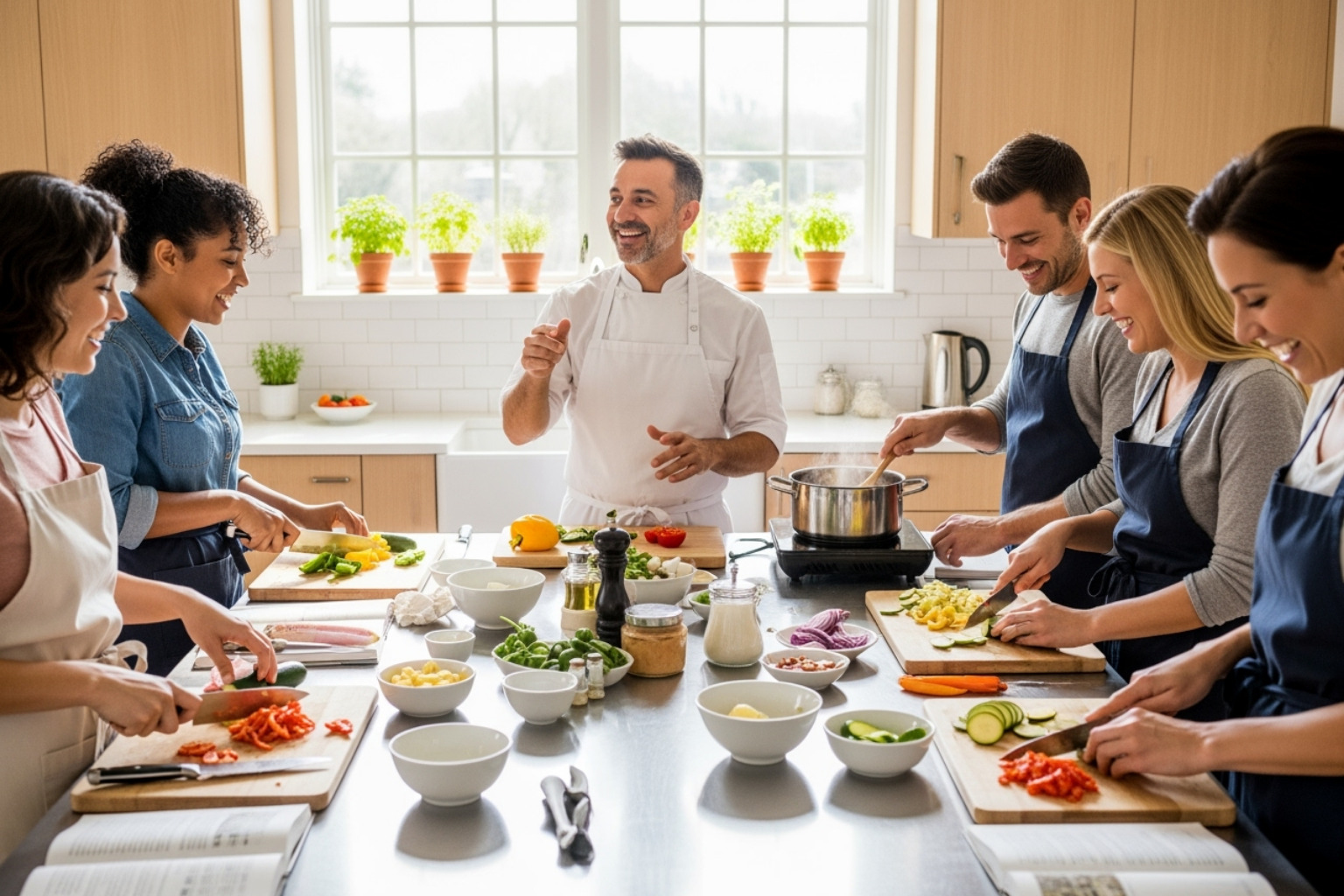
Hands-on cooking classes transform you from observer to participant. You’ll learn not just recipes, but the stories and techniques behind them from locals who grew up with the flavors.
Imagine a Sicilian cooking workshop where each dish reveals the island’s history, or a Khmer cookery class in Cambodia where you learn the secrets of simple, fresh, local cuisine.
These classes go beyond recipes. At places like Sunday Kitchen, a mother-daughter duo weaves family stories into Lebanese cooking lessons, showing how food connects generations.
The best part is that these skills travel home with you, allowing you to share the dishes and stories long after your trip. Find your perfect class with our guides to Local Cooking Classes and Chef-Led Experiences.
Join the Celebration at Food Festivals and Local Events
Food festivals capture a culture’s celebratory spirit, bringing communities together around shared traditions, often tied to harvests or holidays.
Montreal’s MTLàTABLE is a prime example, turning the city into a foodie playground that makes its renowned culinary scene accessible to all.
Themed culinary trails, like the Nanaimo Bar Trail in British Columbia or the Nova Scotia Chowder Trail, offer charming ways to taste regional specialties.
These events foster community bonding over food, creating joy and connection. For more ideas, see our guide to Top Food Festivals Around the World Worth Traveling For.
The Transformative Power of Culinary Travel

A first bite of an unfamiliar dish in a new place can be magical. Cultural food experiences do more than fill our stomachs; they change how we see the world and ourselves, challenging our preconceived notions of what a cuisine should taste like.
This transformative power is reshaping travel, as detailed in How Food Tourism Is Changing the Way We Travel. Travelers plan trips around food, and their stories of life-changing food revelations show how profound these moments are.
Food is a powerful catalyst for change because eating is personal and immediate. A surprising taste can open our minds to new possibilities.
Surprising Food Revelations from Around the World
Travel often turns culinary expectations upside down. You might find exquisite French food or the best pizza ever not in their expected homes, but in Japan. This shows how culinary excellence travels and evolves.
Ramen is a common revelation. Travelers expecting a cheap packet meal find an intricate world of addictive broths and noodles perfected over generations. Learn more about Unique Cultural Experiences in Japan for Tourists.
Even simple findies, like trying mayonnaise on fries in Belgium, can have a big impact, forever changing how we view a familiar food. Ordinary dishes can be revelatory in their proper cultural context.
How a Journey Can Change Your Eating Habits for Life
The magic of cultural food experiences often continues at home, leading to lasting lifestyle changes. Some travelers become vegetarian after visiting India, inspired by its diverse and flavorful plant-based cuisine.
Others adopt new daily rituals, like making pan con tomate for breakfast after a trip to Barcelona, turning a simple meal into a daily celebration.
Similarly, travel in Asia can revolutionize breakfast habits, with many adopting spicy savory noodle soup over cereal. These become permanent shifts in how we approach meals.
These changes contribute to The Flavor Fusion Trend: Mixing Cultures on a Plate, as travelers bring new tastes home, enriching their local food scenes through cultural exchange.
Your Guide to Finding Authentic Eats and Avoiding Tourist Traps
Finding genuine cultural food experiences isn’t about luck. With some preparation and the right mindset, you can avoid tourist traps and find local culinary gems.
Research before you go, but once you arrive, trust your instincts. Our top tip is the “long line of locals” rule: a queue of residents is a sure sign of quality food.
Venturing off the beaten path is key. A noodle shop away from the tourist strip or a family-run bakery in a quiet neighborhood often holds the most authentic treasures.
The value of a good guide is immense. They are cultural translators who explain the history and significance behind dishes, turning a meal into a meaningful experience. Find more strategies in our guide on How to Find Authentic Local Eats in Any City.
| Signs of an Authentic Eatery | Signs of a Tourist Trap |
|---|---|
| Full of locals, especially during peak hours | Empty or mostly tourists |
| Limited menu, often specializing in a few dishes | Extensive, multi-cuisine menu with pictures |
| Simple, often unassuming decor | Overly flashy or themed decor |
| Menu in local language (maybe with small English translation) | Menu in multiple languages, often with inflated prices |
| Cash-only or local payment methods preferred | Accepts all major credit cards, often prominently displayed |
| Food prepared fresh, often to order | Food appears pre-made or reheated |
| Focus on the food and local experience | Focus on souvenir sales or entertainment |
The Value of Guided Food Tours
Guided food tours are a backstage pass to a city’s food scene. They offer more than just restaurant recommendations; they provide a connection to the stories and culture behind the food.
Learning from local experts turns a meal into a cultural lesson. A guide can explain a dish’s history or share a family story, revealing hidden gems in neighborhoods like Chinatown or Little Italy that you’d otherwise miss.
The cultural context is invaluable. A Mexico City street food tour might include 14+ tastings while using public transport. In Christchurch, New Zealand, Amiki Tours’ “Kai Safari” weaves Māori culture into a progressive dinner.
These tours feed your understanding of a place and its people. Explore our resources on Guided Food Tours and Culinary Tour Companies for more.
Leveraging Technology and Local Knowledge
Beyond tours, you can be your own food detective. Using local food blogs and apps provides insider tips on seasonal specialties and new local favorites that guidebooks often miss.
Don’t underestimate the power of a simple conversation. Ask hotel staff, hosts, or shopkeepers for their favorite spots. Their recommendations are often enthusiastic and personal.
Connecting with foodie communities online is another great strategy. Social media groups for specific cities often have locals and expats sharing honest reviews and new findies.
Food Tourism Technology makes finding gems easier, but it’s just a tool. The real magic comes from combining tech with human connection and your own curiosity.
Frequently Asked Questions about Cultural Food Experiences
What defines an ‘authentic’ cultural food experience?
Authenticity in cultural food experiences isn’t about fancy plating; it’s about a genuine connection to a place, its history, and its people.
An authentic experience is eating food that tastes like home to locals. It involves traditional recipes passed down through generations, preserving techniques and flavors.
The magic lies in local ingredients that define a region’s cuisine. Tasting PEI potatoes or a Sicilian tomato is experiencing terroir in its purest form.
Authenticity is about the story and cultural significance of a dish. The value is in understanding the why behind the food, whether it’s a Montreal deli sandwich or a Māori Hāngī feast.
How can I respectfully engage in food experiences in different cultures?
Respectful engagement starts with curiosity and humility. Approach cultural food experiences as a student, not a critic.
- Observe and follow local customs first and foremost.
- Ask permission before photographing people or their food.
- Show genuine appreciation by learning basic phrases like “hello” and “thank you.”
- Support local, family-run businesses to ensure your money benefits the community.
You’re participating in cultural heritage. Be as respectful as you’d want a visitor to be with your own traditions.
Are street food and market stalls safe to eat from?
Yes, street food can be very safe and delicious! The key is knowing what to look for to ensure a great cultural food experience.
- Follow the locals: A long line of residents is a great sign of fresh, popular food.
- Watch the cooking process: Choose vendors who prepare food fresh in front of you.
- Trust your instincts: Assess basic hygiene, like clean utensils and tidy cooking areas.
- Opt for items cooked to order rather than dishes that have been sitting out.
Many street vendors take immense pride in their food, perfecting recipes for years. Our most memorable meals often come from these humble stalls, proving the “cheapest food is often the best.”
Conclusion: Your Culinary Trip Awaits
Food has an extraordinary power to transform us. As we’ve explored, cultural food experiences are windows into a destination’s soul. Each meal, cooking class, or market visit is a bridge to new stories, traditions, and people.
When you eat a street taco in Mexico City or learn to fold dumplings in a home kitchen, you’re doing more than eating—you’re participating in tradition and connecting with culture.
The personal growth from adventurous eating is remarkable. Travelers return with new perspectives and changed habits. The person who goes vegetarian after a trip to India, for example, hasn’t just changed their diet—they’ve changed their worldview.
On your next trip, we encourage you to be adventurous. Say yes to the unknown dish, follow the line of locals, and join a cooking class. These moments of culinary courage create the best memories.
Authentic cultural food experiences are about connection—to place, people, and stories. By exploring a market or learning a family recipe, you’re participating in the ancient tradition of sharing food.
The Dining Destination is here to guide your journey. We help food lovers find hidden gems, avoid traps, and create meaningful connections through cuisine, so you can eat like a local anywhere.
So, pack your appetite. The world is full of flavors, stories, and welcoming tables. Your next great culinary trip awaits.
Ready to start planning? Start planning your next trip by exploring the best destinations for food travel and let your taste buds lead the way to unforgettable memories.

